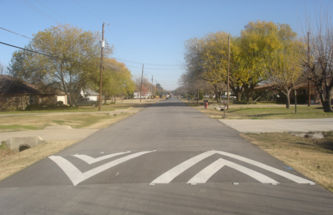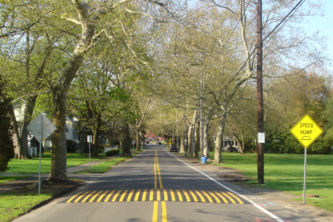| A speed hump (sometimes colloqially called a speed bump) is a rounded traffic calming device used to address issues of excessive vehicle speed and volume on residential streets. Humps are placed across the road to slow traffic and are often installed in a series of several humps in order to prevent cars from speeding before and after the hump. Common speed hump shapes are parabolic, circular, and sinusoidal.
Generally, speed humps are 12 to 14 feet in length and span the width of the road. The height of humps ranges from 3 to 4 inches. The length and height of the speed humps determine the speed at which traffic will travel over the devices. Shorter lengths and greater heights slow cars most drastically. When placed in a series 350-550 feet apart, humps will reduce 85 percentile speeds by 8-10 mph. A warning sign notifies motorists before the first hump in a series. Humps generally have pavement markings to enhance visibility and a taper edge near the curb to allow a gap for drainage. Speed humps are used in locations where very low speeds are desired and reasonable. Speed humps are typically placed on residential roads and are not used on major roads, bus routes, or primary emergency response routes. Placement is generally mid-block between intersections. |
| History
An early implementation of what might be considered to be speed humps was reported on 1906-03-07 in the New York Times. It reported that the U.S. town of Chatham, New Jersey planned to raise its crosswalks five inches above the road level, adding, "This scheme of stopping automobile speeding has been discussed by different municipalities, but Chatham is the first place to put it in practice". Prior to the invention of the automobile and the widespread use of smooth asphalt or concrete pavement, street vehicles could not travel at the sort of speeds at which speed bumps are intended to reduce. According to an Institute of Transportation Engineers publication the first speed bump in Europe was built in 1970 in the city of Delft in the Netherlands. |
| Results
Typical speeds resulting from speed humps are 10-20 mph. Studies show an average 18% reduction in traffic volume and an average 13% reduction in collisions. Comparison to Speed Bumps While similar to the more well known speed bumps, humps are less aggressive than speed bumps and are used on actual streets as opposed to bumps which are primarily placed in parking lots. While speed bumps generally slow cars to 5-10 mph, humps slow cars to 10-20 mph. |
|
Composition
Speed humps are constructed of asphalt, concrete, or rubber. While traditionally most humps were constructed of asphalt or concrete, rubber is becoming increasingly popular due to several factors. Asphalt and concrete can be difficult to construct precisely while rubber products are pre-shaped to standardized sizes and thus consistently meet industry standards. An additional advantage is ease of installation, which is particularly beneficial when a city wants to test streets before deciding where to keep the devices. The simple installation process also allows for relocation during the winter when snow is a concern, which prevents damage to the humps by snow plows. In addition, unlike concrete and asphalt, which necessitate frequent and high cost replacement, rubber products are longer lasting and thus more cost-efficient. |
| Criticisms
One of the most oft heard criticism of speed humps is their effect on emergency vehicles. Response time is slowed by 3-5 seconds per hump for fire trucks and up to 10 seconds for ambulances with patients on-board. Speed humps are thus usually not placed on primary response routes. Speed cushions may be placed on these routes instead. Occasionally, there is an increase in traffic noise from braking and acceleration of vehicles on streets with speed humps, particularly from buses and trucks. Damage caused by snow plows during the winter months is an additional concern. This issue can be alleviated by installing rubber devices and removing them during the snow season. Similar measures Speed tables are longer than speed humps with a flat section in the middle. Cars are slowed to higher speeds than with speed humps. Speed cushions are a series of three humps that are ideal for use on streets when emergency vehicle response time is a concern. Speed bumps are significantly smaller than speed humps and used in areas where speed must be slowed nearly to a halt. |
 |
 |
| Speed hump made of asphalt | Speed hump made of rubber |
